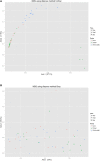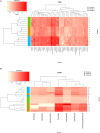Salmonella enterica Serovar Typhimurium Exploits Inflammation to Modify Swine Intestinal Microbiota
- PMID: 26835435
- PMCID: PMC4722131
- DOI: 10.3389/fcimb.2015.00106
Salmonella enterica Serovar Typhimurium Exploits Inflammation to Modify Swine Intestinal Microbiota
Abstract
Salmonella enterica serovar Typhimurium is an important zoonotic gastrointestinal pathogen responsible for foodborne disease worldwide. It is a successful enteric pathogen because it has developed virulence strategies allowing it to survive in a highly inflamed intestinal environment exploiting inflammation to overcome colonization resistance provided by intestinal microbiota. In this study, we used piglets featuring an intact microbiota, which naturally develop gastroenteritis, as model for salmonellosis. We compared the effects on the intestinal microbiota induced by a wild type and an attenuated S. Typhimurium in order to evaluate whether the modifications are correlated with the virulence of the strain. This study showed that Salmonella alters microbiota in a virulence-dependent manner. We found that the wild type S. Typhimurium induced inflammation and a reduction of specific protecting microbiota species (SCFA-producing bacteria) normally involved in providing a barrier against pathogens. Both these effects could contribute to impair colonization resistance, increasing the host susceptibility to wild type S. Typhimurium colonization. In contrast, the attenuated S. Typhimurium, which is characterized by a reduced ability to colonize the intestine, and by a very mild inflammatory response, was unable to successfully sustain competition with the microbiota.
Keywords: Salmonella Typhimurium; immune response; inflammation; microbiota; pig; salmonellosis.
Figures









References
-
- Ammendola S., Pasquali P., Pistoia C., Petrucci P., Petrarca P., Rotilio G., et al. . (2007). High-affinity Zn2+ uptake system ZnuABC is required for bacterial zinc homeostasis in intracellular environments and contributes to the virulence of Salmonella enterica. Infect. Immun. 75, 5867–5876. 10.1128/IAI.00559-07 - DOI - PMC - PubMed
-
- Barthel M., Hapfelmeier S., Quintanilla-Martínez L., Kremer M., Rohde M., Hogardt M., et al. . (2003). Pretreatment of mice with streptomycin provides a Salmonella enterica serovar Typhimurium colitis model that allows analysis of both pathogen and host. Infect. Immun. 71, 2839–2858. 10.1128/IAI.71.5.2839-2858.2003 - DOI - PMC - PubMed
-
- Bearson S. M., Allen H. K., Bearson B. L., Looft T., Brunelle B. W., Kich J. D., et al. . (2013). Profiling the gastrointestinal microbiota in response to Salmonella: low versus high Salmonella shedding in the natural porcine host. Infect. Genet Evol. 16, 330–340. 10.1016/j.meegid.2013.03.022 - DOI - PubMed
Publication types
MeSH terms
LinkOut - more resources
Full Text Sources
Other Literature Sources

